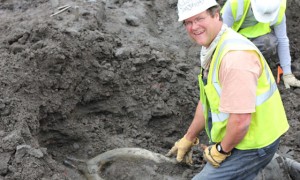Road Report: discoveries in Denver
We’ve all had this experience right? You have a favorite museum that you visit all the time. Then one day, you hear from staff about all the behind-the-scenes work they did to bring something amazing to the museum floor, and you gain a whole new perspective and appreciation of their work.
I had this delightful experience this week. Being from Colorado, I’ve visited the Denver Museum of Nature and Science (DMNS) many times with my family growing up. But I was fortunate to attend one day of the Mountain Plains Museum Association (MPMA) Conference in Aspen this week, and heard two staff from DMNS talk about two very different programs that revealed another dimension of their contributions to the community.
Kirk Johnson, former chief curator (and now director of the National Museum of Natural History at the Smithsonian) gave the keynote talk at the MPMA Conference about their Snowmastodon Project, a massive and utterly unique discovery of Ice Age fossils at Ziegler Reservoir near Snowmass Village in the Colorado Rockies.
In 2010, a bulldozer driver working on an expansion of the Reservoir uncovered bones of a juvenile mammoth. Years later, having tapped an army of volunteers including local school teachers from the Aspen area and world-renowned Ice Age scientists, the Museum recovered over 6000 bones from 50 different species from the site including Ice Age horses, a camel, mastodons of all ages, and a giant bison. There are no other comparable sites at this elevation (over 6000 feet), and the diversity of the mammals represented is extraordinary.
The fossils are now cleaned and preserved, and are in top-rate storage or on view for the benefit of scholars and the public. And the finishing touch? Just this week, the Museum installed a 19-foot bronze sculpture of a mastodon (which would have dwarfed a modern-day elephant by the way). Here’s a timelapse video of its installation.
Later in the afternoon, I sat in on an excellent session with Andréa Giron from the Museum’s Visitor Insights Department (and a Affiliations Visiting Professional alumna). Andréa discussed all the ways the Museum has researched its Latino audiences in particular, and the ways they are honing their programming to attract this important audience. Why? Because the Museum wants its visitation to mirror the demographics of its community (as we all do!), and can boast Latino visitation that is slightly higher than the national average as a result of their efforts. Andréa shared some great ideas such as:
1) crowdsource translation of your materials so they actually make sense to your audience. Google Translate just doesn’t capture nuance!
2) Think about your family membership category. Latino audiences in particular tend to visit in multi-generational groups of 6 or more. DMNS created a Family Plus membership to respond.
3) Language can sometimes be a barrier. Andréa surveyed DMNS staff and found a range of Spanish-speakers, including security and facilities staff, who now wear buttons on the floor offering help to visitors in Spanish. (She also found unexpected speakers of Dutch and ASL experts as well!)
I am always inspired by the great work of our Affiliates, especially when I have the privilege to hear it first-hand from the colleagues doing it. Bravo DMNS! Can’t wait to bring my family back on my next visit to Colorado.
Jennifer Brundage is a National Outreach Manager in Smithsonian Affiliations.




